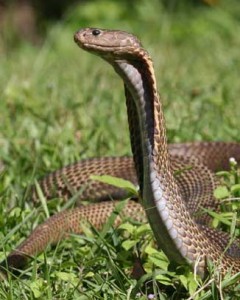In 2011, a young man was brought to the hospital in the city of Cagayan de Oro, Philippines. The man was in extremely poor condition, not able to speak or tell the doctors what even happened. The only information that his family members could provide was that a snake had bitten him. The filipino doctors were baffled. In order to treat the snakebite, they had to know what snake it was. The task was tough, since the tropical nation of the Philippines and its perfect snake-habitat climate is home to dozens of exotic and deadly snakes.
What snake was it?
The doctors and nurses were racing against time, while the patient was going into respiratory arrest. Fortunately, they managed to identify “neurotoxic manifestations”. Meaning—symptoms that affected the nervous system of the patient. Meaning—the snake had neurotoxic venom. People bitten by a neurotoxic snake can die in less than an hour. Filipino Experts claim the only snake in the Philippines that contains a neurotoxic venom is the notorious Philippine Cobra (Naja Philippinesis), a notorious species of Spitting Cobras. Knowing that, the doctors deployed all possible treatments to save the young man, and he survived.
There are three species of spitting cobras that are native to the Philippines: the Equatorial Spitting Cobra, The Southeastern Philippine Cobra, and the Northern Philippine cobra, known also as the Philippine Cobra. This breath-taking snake, according to countless online sources, is the 3rd most dangerous snake in the world, and the deadliest Cobra on the planet. It can spit venom to amazingly long distances, even reaching 9.8 feet (3 meters). And it hits targets dead on. These deadly snakes are native to the northern parts of the Philippines, mainly the islands of Luzon, Mindoro, Catanduanes, and Masbate. Like many other snake species, this deadly Cobra prefers to live in close proximity to water sources, be it lakes, rivers or ponds. It will mostly eat a menu consisting of frogs, mice, small rats and lizards, or even other snakes. Its predators are the famous Mongoose, birds, humans of course, and even his mighty relative, the King Cobra.

Philippine Cobra: The Venom
Among all Cobra species, Toxicological experts claim that Philippine Cobra possess one of the most toxic venoms. One bite from these deadly “sniper” Spitting Cobras can kill a person within half an hour. Their venom has the deadly ability to interrupt the transmission of nerve signals and to cripple respiratory systems. Only the Caspian Cobras (Naja Oxiana) are known to produce a more powerful venom than that of the Filipino species.
In August 2012, a Filipino Zookeeper in the Cebu City Zoo in the Philippines, tried to grab a Philippine Cobra but got bitten in his hand. The alarmed Zookeeper reportedly sucked the venom immediately, but then—swallowed it. In less than half an hour he was unconscious. He was rushed to the hospital, but shockingly there was no anti-venom available in the city of Cebu. The closest hospital with stocks of the anti-venom was in the island province of Camiguin, 256 miles (162 km) from Cebu. Luckily, a private airline by the name of Aviatour came to the rescue, and managed to deliver the anti-venom in time. The Zookeeper survived.
Snake Bites by the Philippine Cobra is a common cause of death among Rice farmers in this tropical country. According to a research by the U.S Naval Medical Research Unit, the death rate from cobras bites was estimated to be as high as 107.1 deaths per 100,000 per year at one site. Approximately 98% of the research victims were males, and only 8% of them reached a hospital.
For more fast facts about Cobras click here.
For FASCINATING facts on the King of all Cobras, click the image below:
For further discussion on snakes, scientific classifications, venom research and much more, check the resources available in “The New Encyclopedia of Snakes”, available on Amazon.com.
 |
Click here to take a glimpse at
|
- If you feel like a having a real Book on Snake Bites, then get this book: ‘Snakes and Snakebite‘ by Visser, J. & Chapman D.S.
- And if you love African Hot snakes, this is THE Book for you: ‘Dangerous Snakes of Africa’ by Spawls, S. and Branch, B.




[…] while they might evoke fear and be rather unpleasant, they tend not to be truly dangerous. The Philippine Cobra, however, is different. It belongs to the subspecies of Cobras known as Spitting Cobras so they […]